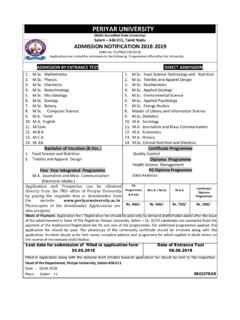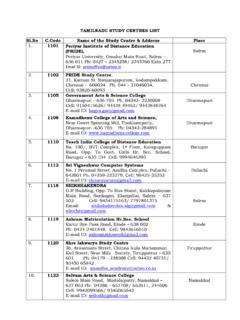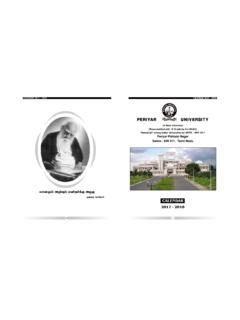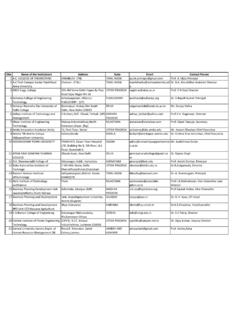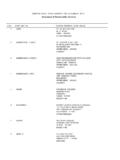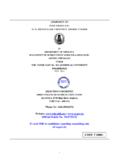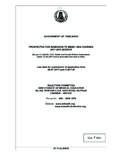Transcription of PERIYAR UNIVERSITY
1 Annexure - 2 PERIYAR UNIVERSITY SALEM 636 011 PERIYAR INSTITUTE OF DISTANCE EDUCATION (PRIDE) MASTER OF COMMERCE REGULATIONS / SYLLABUS (From the Academic Year 2008-2009) Regulations 1. Objectives of the Course 1. To impart knowledge in advanced concepts and applications in various fields of Commerce. 2. To teach the recent developments in the various areas of Commerce 3. To orient the students in the applied aspects of different advanced business practices. 4. To provide the students the avenues of studies in parallel professional Courses. 5. To equip the students to occupy the important positions in business, industries and related organizations. 6. To inspire the students to apply the knowledge gained for the development of society in general.
2 2. Eligibility for Admission Candidates seeking admission to the first year of the Master of Commerce degree course shall possess (a) / (CA) or (b) Any other degree with one paper in Accountancy. 3. Duration of the Course The course shall extend over a period of two academic years The subjects of study shall be in accordance with the syllabus prescribed from time to time. 4. Subjects of Study The total number of subjects of study will be 10 including one project work for 100 marks as an elective. The Project Report must be submitted through the supervisor at the end of the Second year. 5. Classification of the successful Candidates Successful candidates passing the examinations and securing marks 50% and above Pass-Second Class 60% and above Pass-I Class Above 75% in the aggregate I Class with Distinction provided that they pass the examination in the first appearance.
3 6. Scheme of Examinations I YEAR S. Paper Code Title of Duration Max. No the Paper Marks 1 Marketing and 3 Hours 100 Strategic Management 2 Cost and Management Accounting 3 Hours 100 3 Statistical Analysis and Quantitative Techniques 3 Hours 100 4 Corporate Legal Frame work and Security Analysis 3 Hours 100 5 Financial Management and Project Finance 3 Hours 100 II YEAR S. Paper Code Title of Duration Max. No the Paper Marks 6 Research Methodology and E-Commerce 3 Hours 100 7 Taxation 3 Hours 100 8 Global Marketing and Financial Services 3 Hours 100 9 Advanced Corporate Accounting 3 Hours 100 10 Elective (a) Human Resources 3 Hours 100 Management (or) (b) Project work Total 1000 7.
4 Commencement of this Regulation: These regulations shall take effect from the academic year 2008-09, , for students who are to be admitted to the first year of the course during the academic year 2007-08 and thereafter. MARKETING AND STRATEGIC MANAGEMENT Section - A : MARKETING MANAGEMENT Unit: I Introduction Marketing Management Nature And Scope of Marketing. Concepts - Marketing Process Marketing Functions- Market Mix-Market Planning Organizing Market Environment market control and Its Implementation. Unit: II Product Planning and Policy for Old and New Products and Its Implementation- Product Development- Product Life Cycle, Packaging. Unit: III Buying Decision Consumer Behaviour Meaning - Nature Factors Influencing Consumer Behaviour - Controllable and Non Controllable - Buying Decision Process Market Segmentation Customer Life Cycle.
5 Unit: IV Pricing Decision and Distribution Decisions Factors Affecting Price Determination Pricing Policies And Strategies Nature - Functions, Channel of Distribution Types Of Channels Intermediaries Channel Management. Unit: V Promotional Decisions Communication Process Promotional Mix Advertising Other Tools and Techniques Marketing Research and Information. Reference: 1. Doyle Marketing and Strategy 2. Phillip Kotler Principles of Marketing 3. Ramasamy and Namanakumari Marketing Management 4. Stanton, William Jandcharies Future Fundamentals of Marketing 5. Czinkota Marketing Management. Section - B : STRATEGIC MANAGEMENT Unit: I Defining Strategy Strategic Management Mission and Purpose Objective- Goals Stages Functional Level Strategies Environment Analysis Environmental Scanning and Industry Analysis.
6 Unit: II Strategy Formulation And Choice Of Alternatives: Modernization Diversification Integration Merger Takeover And Joint Venture Turn Around Disinvestments And Liquidation Strategies Process Of Strategic Choice Industry Competitor SWOT Analysis Factors Affecting Strategic Choice Generic Competitive Strategies Cost Leadership Differentiation Focus Value Chain Analysis Bench Marking. Unit: III Functional Strategies: Marketing Production Research And Development Financial Operations Purchasing Logistics Human Resource Management Information Systems Strategies. Unit: IV Strategy Implementation Inter Relationship Between Strategy Formulation And Implementation Reengineering And Strategy Implementation Issues In Strategy Implementation Resource Allocation.
7 Unit: V Evaluation And Control In Strategic Management Measuring Performance Types Of Controls Primary Measures Of Divisional And Functional Performance Strategic Information System Guidelines For Proper Control. Note: i) At least One Question In Part-B Should be a Case Study. ii) Each question should have one question from Section - A and one from Section - B. MARKETING AND STRATEGIC MANAGEMENT Model Question Paper Time: 3 Hours Max Marks: 100 PART-A (Answer All Questions) (All Questions Carry equal Marks) 5x5=25 1. a) Explain the factors affecting Marketing Mix. (Or) b) Enumerate the dynamics of internal environment. 2. a) Enumerate the stages in the development of a new product. (Or) b) Write short notes on bench marking 3. a) Explain the types of buying Behaviour.
8 (Or) b) Briefly explain information and systems strategies. 4. a) Discuss the pricing objectives. (Or) b) In procedural implementation, what is the role of the requirements of capital issue control? 5. a) What are the kinds of sales promotion? (Or) b) Write short notes on strategic information system. PART-B (Answer All Questions) (All Questions Carry equal Marks) 5x15=75 6. a) Discuss the facilitating functions of marketing (Or) b) Explain the organizational capability factors. 7. a) Explain the factors to be considered before introducing a new product. (Or) b) Discuss the techniques used in strategic choice. 8. a) Discuss the factors influencing consumer behaviour. (Or) b) What are the various purchasing strategies? Examine the strategy to be adopted while purchasing raw materials at the time of sliding demand for the product.
9 9. a) Explain the pricing strategies. (Or) b) Resource allocation- explain. 10. a) Advertisement Copy Explain (Or) b) What are the guidelines for proper control? COST AND MANAGEMENT ACCOUNTING Section-A : COST ACCOUNTING Unit: I Cost Accounting Meaning And Definition Importance Cost Concept Differences Between Financial Accounting and Cost Accounting Installation of an Ideal Costing System Elements of Cost Classification of Cost Preparation of Cost Sheet Including Tender. Unit: II Material Cost Control Fixation of Various Stock Levels Economic Order Quantity Purchase Procedure Issue of Materials Pricing of Material Issues Inventory Control and Verification. Labour Cost Control Time Keeping Wage Payment and Incentive Schemes Idle Time and Overtime Labour Turn Over.
10 Unit: III Overheads Meaning Classification According To Functions and Variability Apportionment and Reapportionment of Overheads Absorption of Overheads Machine Hour Rate Reconciliation of Cost and Financial Profits. Unit: IV Job Costing Contract Costing Process Costing Losses and Gains Inter Process Profit Equivalent Production Joint and By Products Activity Based Costing Unit: V Marginal Costing meaning and concept advantage and limitations application of marginal costing techniques make or buy, import or make, own or lease key factor break even analysis. Note: Distribution of marks between theory and problems shall be 20% and 80% respectively, as per the model question paper. Reference Books: 1. Maheshwari Principles of Cost Accounting Sultan Chand & Sons, New Delhi.

